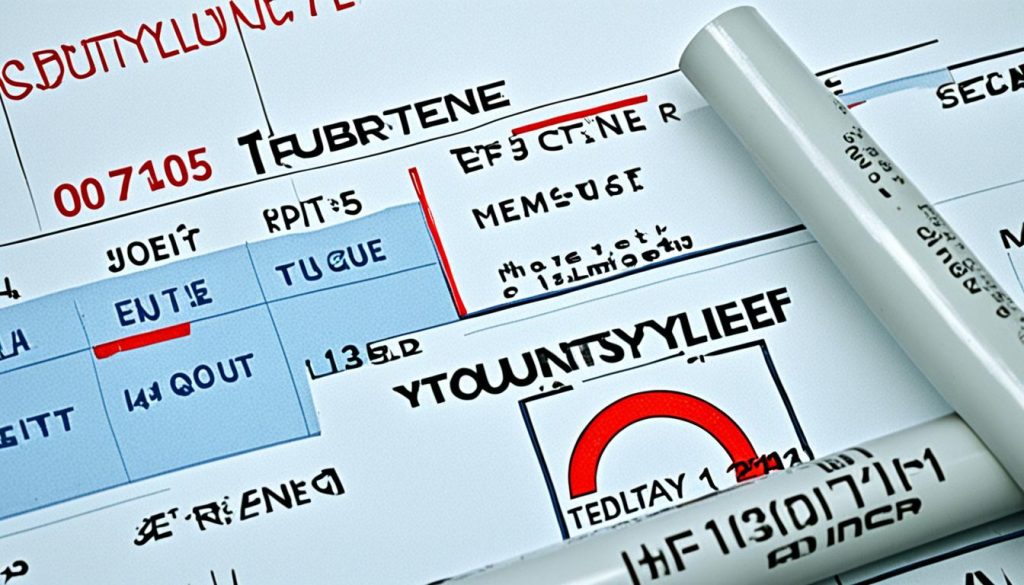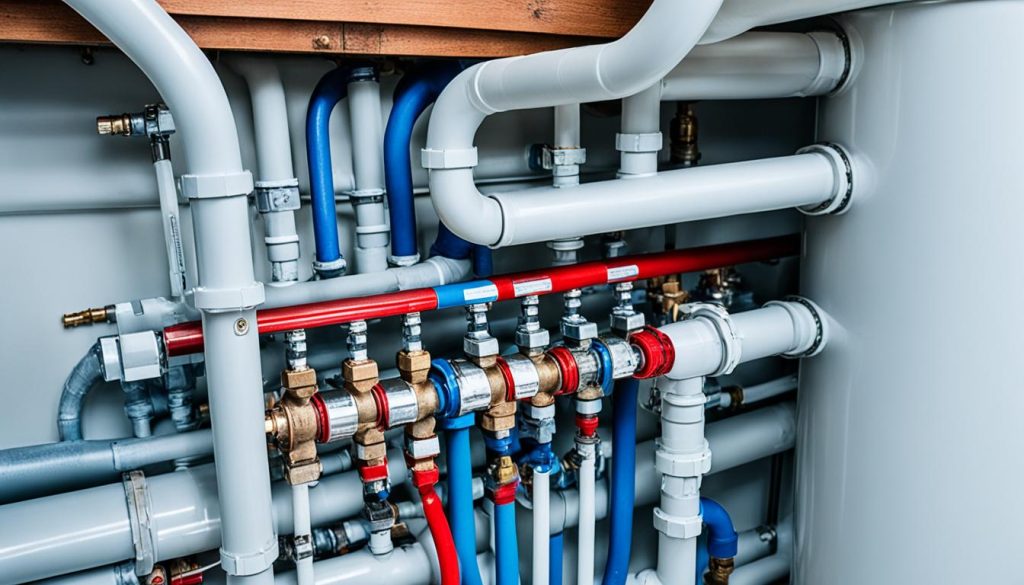Polybutylene Plumbing Ban Date Revealed
Did you know that 95% of homes with polybutylene plumbing experience leaks or breakages? This shocking statistic highlights the widespread impact of a material that was once heralded as an affordable and convenient choice for plumbing.
In Canada, the ban on polybutylene plumbing was officially announced in 1997 by the National Plumbing Code. This ban recognized the high failure rate of polybutylene pipes and deemed them unsuitable for use in any building. The decision was made to protect homeowners from the costly repairs and potential health risks associated with this problematic material.
Key Takeaways:
- The ban on polybutylene plumbing in Canada was implemented in 1997 to address its high failure rate.
- Approximately 95% of homes with polybutylene plumbing experience leaks or breakages.
- Polybutylene pipes are prone to brittleness over time and degradation from sunlight and chemicals.
- Replacing polybutylene plumbing with more reliable materials is strongly advised to avoid costly repairs and potential health risks.
- Consulting a professional plumber is essential to accurately identify and replace polybutylene pipes.
What is Poly B Plumbing?
Poly B plumbing, also known as polybutylene plumbing, was a popular choice for home construction in Canada between the years 1978 and 1995. It was initially chosen for its low production cost compared to steel pipes. However, over time, it became clear that polybutylene pipes were prone to failure and degradation. The material was found to become brittle, leading to leaks and breaks. Poly B plumbing is no longer used in new construction due to its issues, and its use in existing homes is banned. Homeowners with polybutylene plumbing are advised to replace their pipes with more modern and reliable materials like PEX tubing.
Why was Poly B Plumbing outlawed?
Poly B plumbing was outlawed in Canada due to its numerous issues and risks associated with its use. The decision to ban polybutylene piping was prompted by the high failure rate of these pipes, with an estimated 95% of homes experiencing leaks or breaks. The material’s brittleness over time, as well as its susceptibility to degradation from sunlight and chemicals, made it an unreliable choice for plumbing systems. In order to protect homeowners from the potential hazards and costly repairs caused by polybutylene plumbing, the use of these pipes was prohibited.
When Was Poly B Piping Discontinued?
Poly B piping was officially discontinued in Canada in 1997. The ban on polybutylene pipes was imposed by the National Plumbing Code to address the inherent issues and risks associated with this type of plumbing material. The decision to discontinue polybutylene pipes was influenced by the increasing number of lawsuits filed against manufacturers due to property damage caused by leaks and breaks. As a result, suppliers ceased production, leaving homeowners with existing polybutylene plumbing in a difficult situation. Since the ban, polybutylene pipes have been marked as unsafe for use and are no longer sold or recognized as a viable plumbing option.
The discontinuation of polybutylene pipes marked a significant shift in the plumbing industry. However, it also created challenges for homeowners who still have poly B piping installed in their homes. Without access to replacement parts or support from suppliers, addressing issues with polybutylene plumbing becomes a complex and costly endeavor. It is crucial for homeowners with polybutylene pipes to understand the implications of this ban and take appropriate action to ensure the safety and functionality of their plumbing systems.
Key Dates and Legislation
| Date | Event |
|---|---|
| 1978-1995 | Poly B plumbing used in home construction in Canada |
| 1997 | Ban on polybutylene pipes imposed by the National Plumbing Code |
| 1997-Present | Discontinuation of polybutylene pipe production and sales |
The legislation surrounding polybutylene plumbing serves as a reminder of the importance of using reliable and durable materials in construction and maintenance. It is essential for homeowners to stay informed about plumbing regulations to make informed decisions and protect their investment.
Consequences of Having Poly-B Plumbing
Having polybutylene plumbing in your home can lead to a range of consequences. One of the most common issues associated with poly B plumbing is leaking pipes. The material’s tendency to become brittle over time can result in water leaks and significant damage to your home. Repairing polybutylene plumbing can be costly due to the unavailability of replacement parts and the complexity of the repairs. In addition to leaks, polybutylene plumbing can also cause foundation damage and pose health risks. The water that leaks from the pipes can seep into the ground, causing soil expansion and potential foundation cracks. Furthermore, the water may contain harmful bacteria and contaminants, posing a health hazard if ingested.
| Consequences of Poly-B Plumbing | Description |
|---|---|
| Leaking Pipes | The material’s brittleness can lead to frequent water leaks, which can cause significant damage to your home. |
| Costly Repairs | The unavailability of replacement parts and the complexity of the repairs can make fixing polybutylene plumbing expensive. |
| Foundation Damage | Water that leaks from the pipes can seep into the ground, causing soil expansion and potential foundation cracks. |
| Health Risks | Leaking water may contain harmful bacteria and contaminants, posing a health hazard if consumed. |
Leaking Pipes
Polybutylene pipes are prone to becoming brittle over time, leading to frequent leaks. These leaks can result in significant water damage to your home’s walls, floors, and belongings. The constant presence of moisture can also promote the growth of mold and mildew, which can pose health risks to you and your family. Additionally, leaking pipes can contribute to higher water bills and the wastage of a valuable resource.
Costly Repairs
Repairing polybutylene plumbing can be a costly endeavor. Since the material is no longer in production and considered obsolete, replacement parts can be difficult to find. This scarcity of components can drive up the cost of repairs, as specialized plumbers may need to be hired, or alternative solutions may need to be explored. Additionally, the complexity of the repairs involved in replacing polybutylene pipes can further increase the overall expense.
Foundation Damage
Water leaks from polybutylene pipes can seep into the ground surrounding your home, leading to soil expansion. This expansion can cause shifts in the foundation and potentially result in cracks. Foundation damage is a serious issue that can compromise the structural integrity of your home, leading to costly repairs and diminished property value.
Health Risks
Leaking water from polybutylene pipes may contain harmful bacteria and contaminants. If ingested, these contaminants can cause health problems, particularly if they are fecal or chemical in nature. Additionally, water leaks can create a moist environment that encourages the growth of mold and mildew, which can trigger allergies, respiratory issues, and other health concerns.
How Do You Tell If Your Home Has Poly-B?
If you’re uncertain whether your home has polybutylene plumbing, there are a few ways to identify it. Start by inspecting the pipes in your basement or crawl space. Poly B pipes are often grey, black, or blue in color, which can help you distinguish them from other types of pipes.
Another indicator of polybutylene plumbing is the fittings used to connect the pipes. These fittings are typically blue and can be made of plastic or metal. Keep an eye out for these distinctive blue fittings, as they are a strong indication that you have poly B pipes in your home.
If you’re still unsure about the type of plumbing in your home, it’s best to consult a professional plumber. They have the expertise to accurately identify polybutylene pipes and can provide you with a definitive answer.
It’s important to know whether or not your home has polybutylene plumbing so that you can understand the potential risks associated with it. By identifying and acknowledging the presence of poly B pipes, you can take appropriate action to protect your property and ensure the safety of your plumbing system.
| Signs of Poly-B Plumbing | Signs That Do Not Indicate Poly-B Plumbing |
|---|---|
|
|
What Should You Do If You Have Poly-B Plumbing?
If you have polybutylene plumbing in your home, it’s crucial to take steps to protect your property. The best course of action is to replace the poly B pipes as soon as possible. Polybutylene pipes have a high failure rate and can lead to costly repairs, foundation damage, and health risks.
Replacing the pipes with more modern and reliable materials like PEX tubing is recommended. The cost of replacing polybutylene pipes can vary depending on factors such as the size of your home and the number of pipes that need to be replaced. It’s important to consult with a professional plumber to determine the most accurate estimate for your specific project.
Don’t wait to replace polybutylene plumbing – prioritize the safety and well-being of your home. By addressing this issue promptly, you can avoid potential water damage, foundation problems, and health concerns. Contact a qualified plumber today to discuss your options for replacing poly B pipes with compliant and durable alternatives. Take proactive measures to safeguard your property and enjoy peace of mind knowing that your plumbing system is reliable and free from the risks associated with polybutylene pipes.
Source Links
- https://yourguydrainage.ca/what-is-poly-b-plumbing/
- https://www.pbpsa.com/uploads/files/resources/pbpsa-pb1-faq-en-2.pdf
- https://www.washingtonpost.com/archive/realestate/1994/05/28/homeowners-face-choice-on-pipe-removal/43193445-a8d6-4c3e-9ea5-8a8bdb3cd326/
- Investing Wisely: How Windows & Doors in Boost Property Value and Financial Health - April 24, 2025
- The Financial Impact of Personal Injuries: Why Legal Help Matters for Business Owners - April 16, 2025
- The Hidden Financial Costs of Domestic Assault: What Business Owners Need to Know - April 16, 2025













